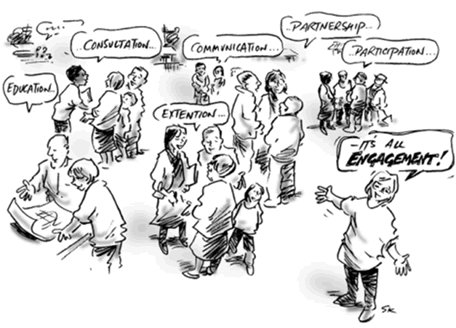While there are almost as many definitions out there as there are people trying to define it, in its simplest terms community engagement seeks to better engage the community to achieve long-term and sustainable outcomes, processes, relationships, discourse, decision-making, or implementation.
To be successful, it must encompass strategies and processes that are sensitive to the community context in which it occurs.

Source: Australian Government Department of Sustainability and Environment
Engagement is not generally driven by a 'model' so much as by a framework of guiding principles, strategies, and approaches. This framework is based on principles that respect the right of all community members to be informed, consulted, involved, and empowered. Community engagement employs a range of tools and strategies to ensure success. It also places a premium on fostering and enhancing trust as a critical element in long-term, sustainable engagement and effective governance.
The word 'community' is also a broad term used to define groups of people, whether they are stakeholders, interest groups, or citizen groups. A community may be a geographic location (community of place), a community of similar interest (community of practice), or a community of affiliation or identity, such as an industry or sporting club. (Adapted from: Department of Environment and Primary Industries )
Community Engagement is… the process of working collaboratively with and through groups of people affiliated by geographic proximity, special interest, or similar situations to address issues affecting the well-being of those people. It is a powerful vehicle for bringing about environmental and behavioral changes that will improve the health of the community and its members. It often involves partnerships and coalitions that help mobilize resources and influence systems, change relationships among partners, and serve as catalysts for changing policies, programs, and practices (CDC, 1997).
'Community engagement' is therefore a strategic process with the specific purpose of working with identified groups of people, whether they are connected by geographic location, special interest, or affiliation, to identify and address issues affecting their well-being.
The linking of the term 'community' to 'engagement' serves to broaden the scope, shifting the focus from the individual to the collective, with the associated implications for inclusiveness to ensure consideration is made of the diversity that exists within any community.
In practice, community engagement is a blend of science and art. The science comes from sociology, public policy, political science, cultural anthropology, organizational development, psychology, social psychology, and other disciplines. It also comes from organizing concepts drawn from the literature on community participation, community development, constituency building, and community psychology. The art comes from the understanding, skill, and sensitivity used to apply and adapt the science in ways that fit the community and the purposes of specific engagement efforts. The results of these efforts may be defined differently and can encompass a broad range of structures (e.g., coalitions, partnerships, collaborations), but they all fall under the general rubric of community engagement and are treated similarly in these discussions (Adapted from ATSDR, 2011).
Community engagement can be complex and labor-intensive, and requires dedicated resources such as time, funding, and people with the necessary skills. Citizens and leaders in communities across the United States, and indeed in many parts of the world, are struggling to make the right choices for the communities and issues they address. Building and implementing effective strategies requires a solid grounding in the best tools, techniques, and information available.
References
"Principles of Community Engagement: First Edition." Centers for Disease Control and Prevention: CDC/ATSDR Committee on Community Engagement, 1997.
"Principles of Community Engagement: Second Edition." Agency for Toxic Substances and Disease Registry (ATSDR), 2011.

